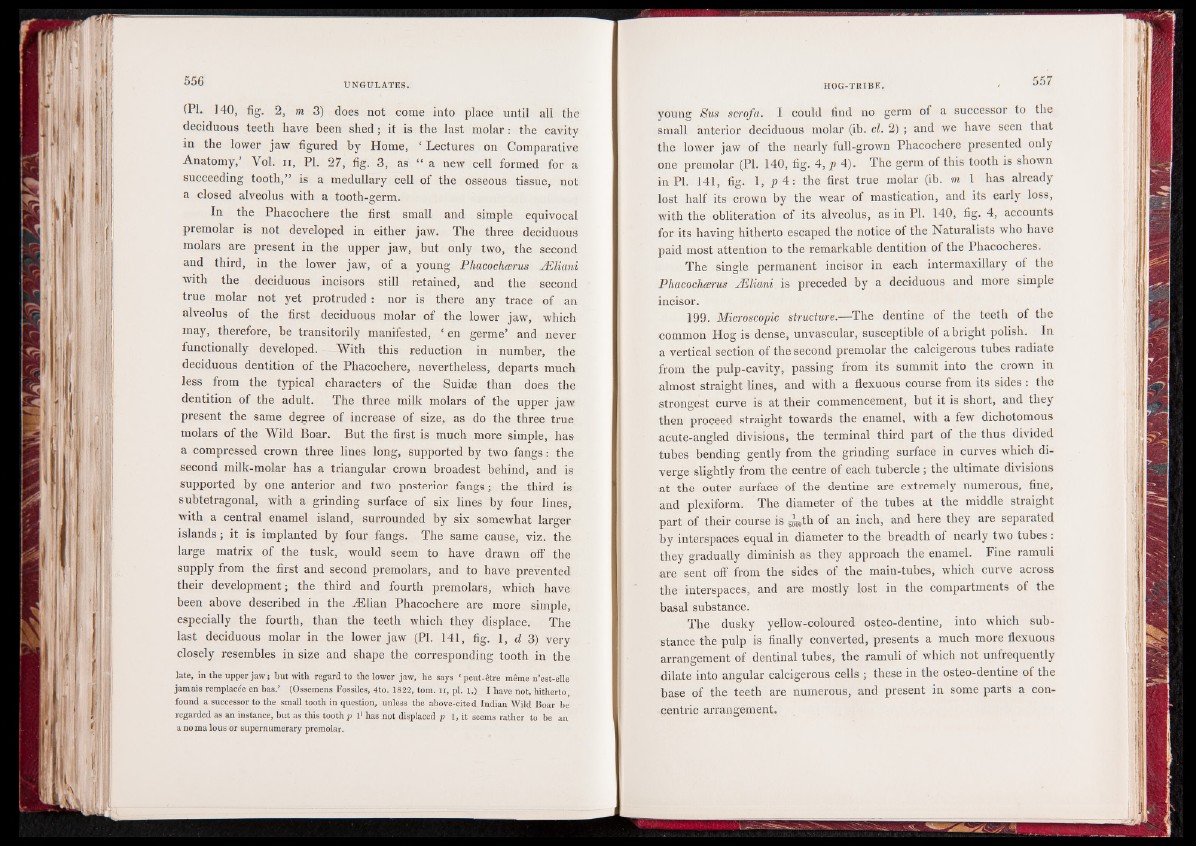
(PI. ] 40, fig. 2, m 3) does not come into place until all the
deciduous teeth have been shed ; it is the last molar : the cavity
in the lower jaw figured by Home, ‘ Lectures on Comparative
Anatomy,’ Vol. n, PI. 27, fig. 3, as “ a new cell formed for a
succeeding tooth,” is a medullary cell of the osseous tissue, not
a closed alveolus with a tooth-germ.
In the Phacochère the first small and simple equivocal
premolar is not developed in either jaw. The three deciduous
molars are present in the upper jaw, but only two, the second
and third, in the lower jaw, of a young Phacochoerus Æliani
■ with the deciduous incisors still retained, and the second
true molar not yet protruded : nor is there any trace of an
alveolus of the first deciduous molar of the lower jaw, which
may, therefore, be transitorily manifested, ‘ en germe’ and never
functionally developed. - With this reduction in number, the
deciduous dentition of the Phacochère, nevertheless, departs much
less from the typical characters of the Suidse than does the
dentition of the adult. The three milk molars of the upper jaw
present the same degree of increase of size, as do the three true
molars of the Wild Boar. But the first is much more simple, has
a compressed crown three lines long, supported by two fangs : the
second milk-molar has a triangular crown broadest behind, and is
supported by one anterior and two posterior fangs ; the third is
subtetragonal, with a grinding surface of six lines by four lines,
with a central enamel island, surrounded by six somewhat larger
islands ; it is implanted by four fangs. The same cause, viz. the
large matrix of the tusk, would seem to have drawn off the
supply from the first and second premolars, and to have prevented
their development ; the third and fourth premolars, which have
been above described in the Ælian Phacochère are more simple,
especially the fourth, than the teeth which they displace. The
last deciduous molar in the lower jaw (PI. 141, fig. 1, d 3) very
closely resembles in size and shape the corresponding tooth in the
late, in the upper jaw ; but with regard to the lower jaw, he says ‘peut-être même n’est-elle
jamais remplacée en bas.’ (Ossemens Fossiles, 4to. 1822, tom. n, pl. i.) I have not, hitherto
found a successor to the small tooth in question, unless the above-cited Indian Wild Boar be
regarded as an instance, but as this tooth p l1 has not displaced p 1, it seems rather to be an
a no ma lous or supernumerary premolar.
young Sus scrofa. I could find no germ of a successor to the
small anterior deciduous molar (ib. cl. 2) ; and we have seen that
the lower jaw of the nearly full-grown Phacochere presented only
one premolar (PI. 140, fig. 4, p 4). The germ of this tooth is shown
in PI. 141, fig. 1, p 4 : the first true molar (ib. m 1 has already
lost half its crown by the wear of mastication, and its early loss,
with the obliteration of its alveolus, as in PI. 140, fig. 4, accounts
for its having hitherto escaped the notice of the Naturalists who have
paid most attention to the remarkable dentition of the Phacocheres.
The single permanent incisor in each intermaxillary of the
Phacochcerus JEliani is preceded by a deciduous and more simple
incisor.
199. Microscopic structure.—The dentine of the teeth of the
common Hog is dense, unvascular, susceptible of a bright polish. In
a vertical section of the second premolar the calcigerous tubes radiate
from the pulp-cavity, passing from its summit into the crown in
almost straight lines, and with a flexuous course from its sides : the
strongest curve is at their commencement, but it is short, and they
then proceed straight towards the enamel, with a few dichotomous
acute-angled divisions, the terminal third part of the thus divided
tubes bending gently from the grinding surface in curves which diverge
slightly from the centre of each tubercle ; the ultimate divisions
at the outer surface of the dentine are extremely numerous, fine,
and plexiform. The diameter of the tubes at the middle straight
part of their course is ^ th of an inch, and here they are separated
by interspaces equal in diameter to the breadth of nearly two tubes :
they gradually diminish as they approach the enamel. Fine ramuli
are sent off from the sides of the main-tubes, which curve across
the interspaces, and are mostly lost in the compartments of the
basal substance.
The dusky yellow-coloured osteo-dentine, into which substance
the pulp is finally converted, presents a much more flexuous
arrangement of dentinal tubes, the ramuli of which not unfrequently
dilate into angular calcigerous cells ; these in the osteo-dentine of the
base of the teeth are numerous, and present in some parts a concentric
arrangement.